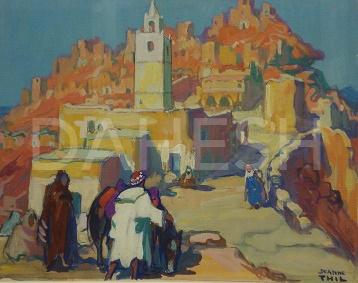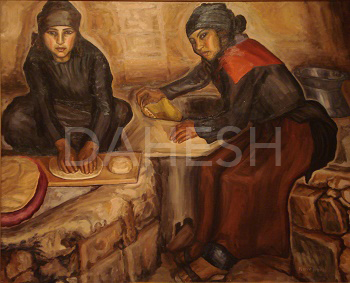By the end of the 19th century many of the restrictions on women’s involvement in the arts had been overcome, but despite these advancements most women could still not travel with the ease enjoyed by men. In the course of the 20th century, however, artists such as the French painter Jeanne Thil broke new ground by traveling to the Middle East and North Africa to paint. But just as Thil ventured abroad, women from the Middle East like Marie Hadad set out for Europe in pursuit of artistic careers. The stories of Thil and Hadad illustrate how women artists overcame one of the final obstacles in their path, the ability to travel, and how this privilege profoundly shaped their careers.
Thil achieved fame as an Orientalist painter after winning a travel stipend in 1921, which allowed her to visit North Africa to paint. There she created striking images of the people and landscape, such as Troglodyte Village at Chenini (above, left), which transported viewers into distant regions and cultures. These works gained her two silver medals (1920, 1937) and a gold (1924) at the Salon, the Prix James Bertrand and the Prix Brizard (1925), and nomination to the Legion of Honor (1938). As Thil’s fame grew, she also received government commissions for large mural decorations in France and North Africa (e.g. Palais Tunisien and the Musée des Colonies). By 1933 Thil had become so well known for travel images that the critic Camille Mauclair lauded her as “not just among the best female painters, but one of the best history and orientalist painters of our time.”
Born two years after Thil, Hadad was a self-taught painter, celebrated for her sensitively rendered portraits of people from her homeland and intimate views of daily life, as in Two Women Kneading Dough (above, right). Hadad came to widespread attention in 1933 after showing such works in a one woman show at the Georges Bernheim Gallery in Paris—even selling her painting Lebanese Highlander to the government for the museum of the Jeu de Paume. After seeing this exhibition, the critic Louis Vauxcelles praised Hadad for “revealing to us flowers, animals, light, and types of people, whom our painters hardly study.” Hadad went on to display paintings around the world, showing as a featured artist in the Lebanon Republic Pavilion at the 1939 World’s Fair in New York, and at the International Exhibition in Cleveland, Ohio in 1941. Hadad and Thil were women who both saw and painted the world, and in the process won acclaim for the perceptive and vivid views of the Middle East that they shared with others.




